Elemental Composition of Particulate Matter in the Euphotic and Benthic Boundary Layers of the Barents and Norwegian Seas
Abstract
:1. Introduction
2. Materials and Methods
2.1. Study Area
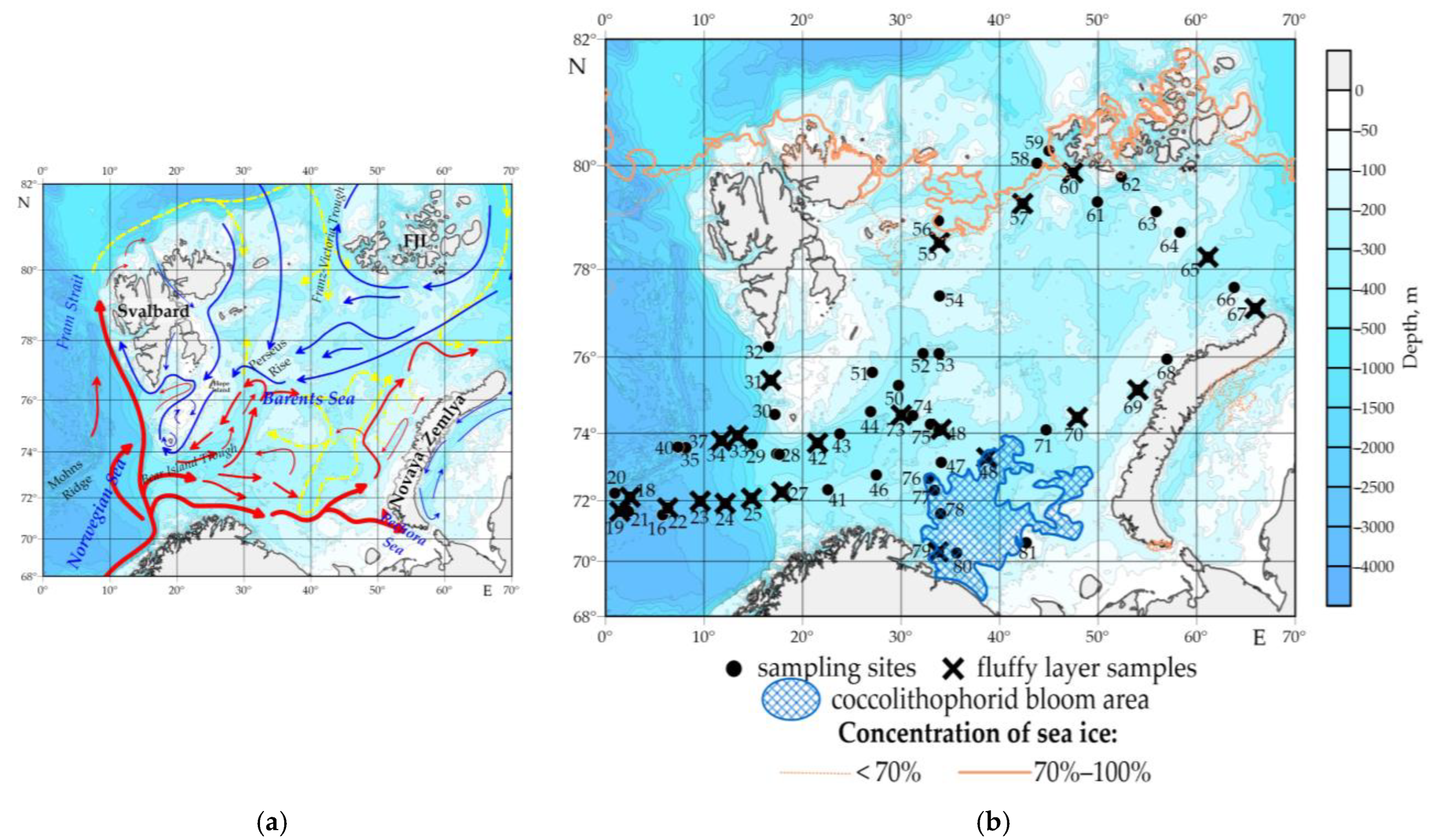
2.2. Field Observations and Sample Collection
2.3. Determination of Major Particulate Phases
2.4. Elemental Analyses of Particulate Matter
3. Results
3.1. Hydrological Conditions
3.2. Concentration of SPM
3.3. Major Phase Composition of SPM
3.4. Elemental Composition of SPM
3.5. FLSM Compostion
4. Discussion
4.1. SPM Distribution in the Euphotic Layer
4.2. SPM Vertical Distribution and Major Phase Composition
4.3. Correlations between TE and Major Phases of SPM
4.4. Spatial Distribution of Elements in SPM of Euphotic Layer and BBL
4.5. Comparison of BNL SPM and FLSM Composition
5. Conclusions
Supplementary Materials
Author Contributions
Funding
Data Availability Statement
Acknowledgments
Conflicts of Interest
References
- Lisitzin, A.P. Oceanic Sedimentation: Lithology and Geochemistry; American Geophysical Union Press: Washington, DC, USA, 1996; pp. 1–400. [Google Scholar] [CrossRef]
- Jeandel, C.; van der Loeff, M.R.; Lam, P.J.; Roy-Barman, M.; Sherrell, R.M.; Kretschmer, S.; German, C.; Dehairs, F. What did we learn about ocean particle dynamics in the GEOSECS–JGOFS era? Prog. Oceanogr. 2015, 133, 6–16. [Google Scholar] [CrossRef] [Green Version]
- Lam, P.J.; Lee, J.-M.; Heller, M.I.; Mehic, S.; Xiang, Y.; Bates, N.R. Size-fractionated distributions of suspended particle concentration and major phase composition from the U.S. GEOTRACES Eastern Pacific Zonal Transect (GP16). Mar. Chem. 2018, 201, 90–107. [Google Scholar] [CrossRef]
- Hill, P.S.; Nowell, A.R.M. Comparison of two models of aggregation in continental-shelf bottom boundary layers. J. Geophys. Res. 1995, 100, 22749–22763. [Google Scholar] [CrossRef]
- Etiope, G.; Favali, P.; Fuda, J.L.; Italiano, F.; Laubenstein, M.; Millot, C.; Plastino, W. The Benthic Boundary Layer: Geochemical and oceanographic data from the GEOSTAR-2 observatory. Ann. Geophys. 2006, 49, 705–713. [Google Scholar] [CrossRef]
- Pempkowiak, J.; Bełdowski, J.; Pazdro, K.; Staniszewski, A.; Leipe, T.; Emeis, K.C. The contribution of the fine sediment fraction to the Fluffy Layer Suspended Matter (FLSM). Oceanologia 2002, 44, 513–527. [Google Scholar]
- Ziervogel, K.; Forster, S. Aggregation and sinking behaviour of resuspended fluffy layer material. Cont. Shelf Res. 2005, 25, 1853–1863. [Google Scholar] [CrossRef]
- Lein, A.Y.; Kravchishina, M.; Politova, N.; Savvichev, A.S.; Veslopolova, E.F.; Mitskevich, I.N.; Ul’Yanova, N.V.; Shevchenko, V.; Ivanov, M.V. Transformation of particulate organic matter at the water-bottom boundary in the Russian Arctic seas: Evidence from isotope and radioisotope data. Lithol. Miner. Resour. 2012, 47, 99–128. [Google Scholar] [CrossRef]
- Pavlov, A.K.; Stedmon, C.A.; Semushin, A.V.; Martma, T.; Ivanov, B.V.; Kowalczuk, P.; Granskog, M.A. Linkages between the circulation and distribution of dissolved organic matter in the White Sea, Arctic Ocean. Cont. Shelf Res. 2016, 119, 1–13. [Google Scholar] [CrossRef] [Green Version]
- Tsubouchi, T.; Våge, K.; Hansen, B.; Larsen, K.M.H.; Østerhus, S.; Johnson, C.; Jónsson, S.; Valdimarsson, H. Increased ocean heat transport into the Nordic Seas and Arctic Ocean over the period 1993–2016. Nat. Clim. Chang. 2021, 11, 21–26. [Google Scholar] [CrossRef]
- Overland, J.; Dunlea, E.; Box, J.E.; Corell, R.; Forsius, M.; Kattsov, V.; Olsen, M.S.; Pawlak, J.; Reiersen, L.-O.; Wang, M. The urgency of Arctic change. Polar Sci. 2019, 21, 6–13. [Google Scholar] [CrossRef]
- Honeyman, B.D.; Balistrieri, L.S.; Murray, J. Oceanic trace metal scavenging: The importance of particle concentration. Deep. Sea Res. Part A Oceanogr. Res. Pap. 1988, 35, 227–246. [Google Scholar] [CrossRef]
- Horner, T.J.; Little, S.H.; Conway, T.M.; Farmer, J.R.; Hertzberg, J.E.; Janssen, D.J.; Lough, A.J.M.; McKay, J.L.; Tessin, A.; Galer, S.J.G.; et al. Bioactive Trace Metals and Their Isotopes as Paleoproductivity Proxies: An Assessment Using GEOTRACES-Era Data. Glob. Biogeochem. Cycles 2021, 35, e2020GB006814. [Google Scholar] [CrossRef]
- Pedersen, R.B.; Rapp, H.T.; Thorseth, I.H.; Lilley, M.D.; Barriga, F.; Baumberger, T.; Flesland, K.; Fonseca, R.; Früh-Green, G.L.; Jørgensen, S.L. Discovery of a black smoker vent field and vent fauna at the Arctic Mid-Ocean Ridge. Nat. Commun. 2010, 1, 126. [Google Scholar] [CrossRef] [Green Version]
- Pedersen, P.B.; Bjerkgard, T. Massive sulphides in Arctic waters. In Mineral Resources in the Arctic; Boyd, R., Ed.; NGU Geological Survey of Norway: Trondheim, Norway, 2016; pp. 210–215. [Google Scholar]
- Klyuvitkin, A.A.; Kravchishina, M.D.; Boev, A.G. Particle Fluxes in Hydrothermal Vent Fields of the Southern Part of the Mohns Ridge. Dokl. Earth Sci. 2021, 497, 200–205. [Google Scholar] [CrossRef]
- Shevchenko, V.P.; Lein, A.Y.; Zernova, W.; Ivanov, G.I.; Lisitzin, A.P. The distribution and composition of suspended matter and phytoplankton in the surface layer of Norwegian and Greenland seas in august 1996. Dokl. Earth Sci. 1997, 335, 805–807. [Google Scholar]
- Shevchenko, V.P.; Burovkin, A.A.; Zernova, V.V.; Shanin, S.S.; Ivanov, G.I.; Polyak, L.V.; Dzhinoridze, R.N. Sedimentary material flows in the St. Anna Trough and Eastern Barents Sea. Dokl. Earth Sci. 1998, 359A, 400–403. [Google Scholar]
- Aibulatov, N.A.; Matyushenko, V.A.; Shevchenko, V.P.; Politova, N.V. New data on the transverse structure of lateral flows of the suspended material along the Barents Sea periphery. Environ. Geosci. 1999, 6, 526–540. (In Russian) [Google Scholar]
- Lukashin, V.N.; Bogdanov, Y.A.; Shevchenko, V.P.; Rusakov, V.Y.; Isaeva, A.B. A study of vertical fluxes of sedimentary material and its composition in the Norwegian Sea in the summer periods of 1991–1995. Geochem. Int. 2000, 38, 169–183. [Google Scholar]
- Lukashin, V.N. Geochemistry of suspended matter and sinking material in the eastern Norwegian Sea. Geochem. Int. 2008, 46, 711–723. [Google Scholar] [CrossRef]
- Lukashin, V.N. Sedimentary matter fluxes in the contour current sedimentation system over the continental slope of the Norwegian Sea. Oceanology 2008, 48, 701–709. [Google Scholar] [CrossRef]
- Politova, N.V.; Shevchenko, V.P.; Zernova, V.V. Distribution, Composition, and Vertical Fluxes of Particulate Matter in Bays of Novaya Zemlya Archipelago, Vaigach Island at the End of Summer. Adv. Meteorol. 2012, 2012, 259316. [Google Scholar] [CrossRef] [Green Version]
- Murdmaa, I.O.; Bogdanova, O.Y.; Gorshkov, A.I.; Novikov, G.V.; Shevchenko, V.P. Iron and Manganese Minerals in Suspended Matter from the Barents Sea. Lithol. Miner. Resour. 2000, 35, 594–597. [Google Scholar] [CrossRef]
- Politova, N.V.; Kravchishina, M.D.; Novigatsky, A.N.; Lokhov, A.S. Dispersed Sedimentary Matter of the Barents Sea. Oceanology 2019, 59, 697–714. [Google Scholar] [CrossRef]
- Shevchenko, V.P.; Politova, N.V.; Aibulatov, N.A. Quantitative distribution and compistion of suspended matter in the coastal area of the Pechora Sea. In The Mankind and the Coastal Zone of the World Ocean in XXI Century; Aibulatov, N.A., Ed.; GEOS: Moscow, Russia, 2000; pp. 23–250. (In Russian) [Google Scholar]
- Shevchenko, V.P.; Politova, N.V.; Aibulatov, N.A. Water suspended matter and its fluxes. In The Pechora Sea: Systematic Research (Hydrophysics, Hydrology, Optics, Bilogy, Chemistry, Geology, Ecology, Social and Economic Issues); Romankevich, E.A., Ed.; More: Moscow, Russia, 2003; pp. 247–262. (In Russian) [Google Scholar]
- Politova, N.V. Features of the Distribution and Composition of Suspended Particulate Matter and Sedimentary Fluxes in the Barents and Pechora Seas. Ph.D. Thesis, Shirshov Institute of Oceanology RAS, Moscow, Russia, 30 October 2007. (In Russian). [Google Scholar]
- Pfirman, S.L. Modern Sedimentation in the Northern Barents Sea: Input, Dispersal, and Deposition of Suspended Sediments from Glacial Meltwater. Ph.D. Thesis, Massachusetts Institute of Technology, The Woods Hole Oceanographic Institution, Woods Hole, MA, USA, August 1984. [Google Scholar] [CrossRef]
- Buettner, S.; Ivanov, V.V.; Kassens, H.; Kusse-Tiuz, N.A. Distribution of suspended particulate matter in the Barents Sea in late winter 2019. Arct. Antarct. Res. 2020, 66, 267–278. [Google Scholar] [CrossRef]
- Rusakov, V.Y.; Lisitsyn, A.P.; Izotova, S.S.; Moskalev, A.S.; Gazenko, A.O.; Rahold, F. Distribution and mineral composition of particulate matter in the Franz Victoria Trough (Northern Barents Sea). Oceanology 2004, 44, 247–256. [Google Scholar]
- Matishov, G.G.; Mityaev, M.V.; Khasankaev, V.B.; Tarasov, G.A.; Golubev, V.A. Regions of recent sedimentary material accumulation in the Medvezhii Trench, Barents Sea. Dokl. Earth Sci. 2002, 385, 567–569. [Google Scholar]
- Lukashin, V.N.; Shcherbinin, A.D. Hydrological properties, suspended matter, and particulate fluxes in the water column of the Bear Island Trough. Oceanology 2007, 47, 68–79. [Google Scholar] [CrossRef]
- Ivanov, G.I. Geoecology of Western Arctic Shelf of Russia: Lithological and Ecogeochemical Aspects; Nauka: Saint-Petersburg, Russia, 2006; pp. 1–303. (In Russian) [Google Scholar]
- McPhee, E.E.; Nowell, A.R.; Sternberg, R.W. Boundary layer measurements and their implications for sediment transport on the eastern Norwegian Sea continental slope. Deep Sea Res. 1998, 45, 719–743. [Google Scholar] [CrossRef]
- Frey, D.I.; Novigatsky, A.N.; Kravchishina, M.D.; Morozov, E.G. Water structure and currents in the Bear Island trough in July--August 2017. Russ. J. Earth Sci. 2017, 17, ES3003. [Google Scholar] [CrossRef] [Green Version]
- King, E.L.; Bøe, R.; Bellec, V.K.; Rise, L.; Skarðhamar, J.; Ferré, B.; Dolan, M.F. Contour current driven continental slope-situated sandwaves with effects from secondary current processes on the Barents Sea margin offshore Norway. Mar. Geol. 2014, 353, 108–127. [Google Scholar] [CrossRef] [Green Version]
- Loeng, H. Features of the physical oceanographic conditions of the Barents Sea. Polar Res. 1991, 10, 5–18. [Google Scholar] [CrossRef] [Green Version]
- Pisarev, S.V. Review of the Barents Sea hydrological conditions. In Barents Sea System; Lisitzin, A.P., Ed.; GEOS: Moscow, Russia, 2021; pp. 153–166. (In Russian) [Google Scholar] [CrossRef]
- Lind, S.; Ingvaldsen, R.B.; Furevik, T. Arctic warming hotspot in the northern Barents Sea linked to declining sea-ice import. Nat. Clim. Chang. 2018, 8, 634–639. [Google Scholar] [CrossRef]
- Polyakov, I.V.; Rippeth, T.P.; Fer, I.; Alkire, M.B.; Baumann, T.M.; Carmack, E.C.; Ingvaldsen, R.; Ivanov, V.V.; Janout, M.; Lind, S.; et al. Weakening of Cold Halocline Layer Exposes Sea Ice to Oceanic Heat in the Eastern Arctic Ocean. J. Clim. 2020, 33, 8107–8123. [Google Scholar] [CrossRef]
- Kopelevich, O.V.; Sahling, I.V.; Vazyulya, S.V.; Glukhovets, D.I.; Sheberstov, S.V.; Burenkov, V.I.; Karalli, P.G.; Yushmanova, A.V. Bio-Optical Characteristics of the Seas, Surrounding the Western Part of Russia, from Data of the Satellite Ocean Color Scanners of 1998–2017; OOO “VASh FORMAT”: Moscow, Russia, 2018; pp. 1–42. (In Russian) [Google Scholar]
- Kopelevich, O.; Sheberstov, S.; Vazyulya, S. Effect of a Coccolithophore Bloom on the Underwater Light Field and the Albedo of the Water Column. J. Mar. Sci. Eng. 2020, 8, 456. [Google Scholar] [CrossRef]
- Kopelevich, O.V.; Vazyulya, S.V.; Gluhovets, D.I.; Saling, I.V. Biooptical characteristics and solar radiation in the surface layer of the Barents Sea. In Barents Sea System; Lisitzin, A.P., Ed.; GEOS: Moscow, Russia, 2021; pp. 236–245. (In Russian) [Google Scholar] [CrossRef]
- Pautova, L.A.; Silkin, V.A.; Kravchishina, M.D.; Chultsova, A.L.; Lisitzin, A.P. The Biological Calcium Carbonate Pump in the Norwegian and Barents Seas: Regulation Mechanisms. Dokl. Earth Sci. 2020, 490, 46–50. [Google Scholar] [CrossRef]
- Silkin, V.; Pautova, L.; Giordano, M.; Kravchishina, M.; Artemiev, V. Interannual variability of Emiliania huxleyi blooms in the Barents Sea: In situ data 2014–2018. Mar. Pollut. Bull. 2020, 158, 111392. [Google Scholar] [CrossRef]
- Review Ice Charts for the Arctic Ocean. Available online: http://old.aari.ru/odata/_d0015.php?lang=1&mod=0&yy=2017 (accessed on 9 December 2022).
- Jakobsson, M.; Mayer, L.A.; Bringensparr, C.; Castro, C.F.; Mohammad, R.; Johnson, P.; Ketter, T.; Accettella, D.; Amblas, D.; An, L.; et al. The International Bathymetric Chart of the Arctic Ocean Version 4.0. Sci. Data 2020, 7, 176. [Google Scholar] [CrossRef]
- Kravchishina, M.D.; Novigatskii, A.N.; Savvichev, A.S.; Pautova, L.A.; Lisitsyn, A.P. Studies on Sedimentary Systems in the Barents Sea and Norwegian–Greenland Basin during Cruise 68 of the R/V Akademik Mstislav Keldysh. Oceanology 2019, 59, 158–160. [Google Scholar] [CrossRef]
- Schlitzer, R. Ocean Data View; AWI: Bremerhaven, Germany, 2021. [Google Scholar]
- Krishnaswami, S.; Sarin, M. Atlantic surface particulates: Composition, settling rates and dissolution in the deep sea. Earth Planet. Sci. Lett. 1976, 32, 430–440. [Google Scholar] [CrossRef]
- Gelman, E.M.; Starobina, I.Z. Photometric Methods for Determining Rock-Forming Elements in Ores, Rocks and Minerals; GEOKHI AS USSR: Moscow, Russia, 1976; pp. 1–69. (In Russian) [Google Scholar]
- Rudnick, R.L.; Gao, S. Composition of the Continental Crust. In Treatise on Geochemistry; Rudnick, R.L., Holland, H.D., Turekian, K.K., Eds.; Elsevier: Amsterdam, The Netherlands, 2003; Volume 3, pp. 1–64. [Google Scholar]
- Lukashin, V.N.; Krechik, V.A.; Klyuvitkin, A.A.; Starodymova, D.P. Geochemistry of Suspended Particulate Matter in the Marginal Filter of the Pregolya River (Baltic Sea). Oceanology 2018, 58, 856–869. [Google Scholar] [CrossRef]
- Kopelevich, O.V.; Vazyulya, S.V.; Grigoriev, A.V.; Khrapko, A.N.; Sheberstov, S.V.; Sahling, I.V. Penetration of visible solar radiation in waters of the Barents Sea depending on cloudiness and coccolithophore blooms. Oceanology 2017, 57, 402–409. [Google Scholar] [CrossRef]
- Hancke, K.; Hovland, E.K.; Volent, Z.; Pettersen, R.; Johnsen, G.; Moline, M.; Sakshaug, E. Optical properties of CDOM across the Polar Front in the Barents Sea: Origin, distribution and significance. J. Mar. Syst. 2014, 130, 219–227. [Google Scholar] [CrossRef] [Green Version]
- Glukhovets, D.; Kopelevich, O.; Yushmanova, A.; Vazyulya, S.; Sheberstov, S.; Karalli, P.; Sahling, I. Evaluation of the CDOM Absorption Coefficient in the Arctic Seas Based on Sentinel-3 OLCI Data. Remote Sens. 2020, 12, 3210. [Google Scholar] [CrossRef]
- Smyth, T.J.; Tyrrell, T.; Tarrant, B. Time series of coccolithophore activity in the Barents Sea, from twenty years of satellite imagery. Geophys. Res. Lett. 2004, 31, L11302. [Google Scholar] [CrossRef] [Green Version]
- Pautova, L.A.; Silkin, V.A.; Kravchishina, M.D.; Yakubenko, V.G.; Chultsova, A.L. Summer phytoplankton of the northern Barents Sea (75–80° N). Hydrosphere Ecol. 2019, 2, 8–19. (In Russian) [Google Scholar] [CrossRef]
- Kravchishina, M.D.; Novigatsky, A.N.; Savvichev, A.S.; Pautov, L.A.; Lisitzin, A.P. Sedimentation systems definition of the Barents Sea and Norwegian-Greenland basin during 68th cruise of the research vessel Academic Mstislav Keldysh. Okeanologiya 2019, 59, 173–176. [Google Scholar] [CrossRef]
- Box, J.E.; Colgan, W.T.; Wouters, B.; Burgess, D.O.; O’Neel, S.; Thomson, L.I.; Mernild, S.H. Global sea-level contribution from Arctic land ice: 1971–2017. Environ. Res. Lett. 2018, 13, 125012. [Google Scholar] [CrossRef] [Green Version]
- Faust, J.C.; Stevenson, M.A.; Abbott, G.D.; Knies, J.; Tessin, A.; Mannion, I.; Ford, A.; Hilton, R.; Peakall, J.; März, C. Does Arctic warming reduce preservation of organic matter in Barents Sea sediments? Philos. Trans. R. Soc. 2020, 378, 20190364. [Google Scholar] [CrossRef] [PubMed]
- Lisitsin, A.P.; Shevchenko, V.P.; Burenkov, V.I. Hydrooptics and suspended matter of Arctic seas. Atmos. Ocean. Opt. 2000, 13, 61–71. [Google Scholar]
- Kravchishina, M.D.; Lein, A.Y.; Sukhanova, I.N.; Artem’Ev, V.A.; Novigatsky, A.N. Genesis and spatial distribution of suspended particulate matter concentrations in the Kara Sea during maximum reduction of the Arctic ice sheet. Oceanology 2015, 55, 623–643. [Google Scholar] [CrossRef]
- Laukert, G.; Makhotin, M.; Petrova, M.V.; Frank, M.; Hathorne, E.C.; Bauch, D.; Böning, P.; Kassens, H. Water mass transformation in the Barents Sea inferred from radiogenic neodymium isotopes, rare earth elements and stable oxygen isotopes. Chem. Geol. 2019, 511, 416–430. [Google Scholar] [CrossRef]
- Bogdanov, Y.A.; Sagalevitch, A.M.; Galkin, S.M.; Tchernyaev, E.S.; Lukashin, V.N.; Ivanov, G.V. Geological and biological investigation in the northern part of the Mohn’s Ridge (Norwegian Sea). Oceanology 1997, 37, 548–555. [Google Scholar]
- Lobus, N.V.; Kulikovskiy, M.S.; Maltsev, Y.I. Multi-Element Composition of Diatom Chaetoceros spp. from Natural Phytoplankton Assemblages of the Russian Arctic Seas. Biology 2021, 10, 1009. [Google Scholar] [CrossRef] [PubMed]
- Duhamel, S.; Diaz, J.M.; Adams, J.C.; Djaoudi, K.; Steck, V.; Waggoner, E.M. Phosphorus as an integral component of global marine biogeochemistry. Nat. Geosci. 2021, 14, 359–368. [Google Scholar] [CrossRef]
- Mart, L.; Nürnberg, H.W.; Rützel, H. Comparative Studies on Cadmium Levels in the North Sea, Norwegian Sea, Barents Sea and the Eastern Arctic Ocean. In Environmental Research and Protection; Fresenius, W., Lüderwald, I., Eds.; Springer: Berlin/Heidelberg, Germany, 1984; pp. 201–209. [Google Scholar] [CrossRef]
- Bruland, K.W.; Lohan, M.C. Controls of trace metals in seawater. In Treatise on Geochemistry: The Oceans and Marine Geochemistry; Elderfield, H., Ed.; Elsevier: New York, NY, USA, 2004; Volume 6, pp. 23–47. [Google Scholar]
- Ho, T.-Y.; Quigg, A.; Finkel, Z.V.; Milligan, A.J.; Wyman, K.; Falkowski, P.G.; Morel, F.M.M. The elemental composition of some marine phytoplankton1. J. Phycol. 2003, 39, 1145–1159. [Google Scholar] [CrossRef]
- Simpson, W. A critical review of Cadmium in the Marine environment. Prog. Oceanogr. 1981, 10, 1–70. [Google Scholar] [CrossRef] [Green Version]
- Zheng, Y.; Anderson, R.F.; van Geen, A.; Fleisher, M.Q. Preservation of particulate non-lithogenic uranium in marine sediments. Geochim. Cosmochim. Acta 2002, 66, 3085–3092. [Google Scholar] [CrossRef]
- Zheng, Y.; Anderson, R.F.; van Geen, A.; Fleisher, M.Q. Remobilization of authigenic uranium in marine sediments by bioturbation. Geochim. Cosmochim. Acta 2002, 66, 1759–1772. [Google Scholar] [CrossRef]
- Stoll, H. Calcification rate and temperature effects on Sr partitioning in coccoliths of multiple species of coccolithophorids in culture. Glob. Planet. Chang. 2002, 34, 153–171. [Google Scholar] [CrossRef] [Green Version]
- Paasche, E. A review of the coccolithophorid Emiliania huxleyi (Prymnesiophyceae), with particular reference to growth, coccolith formation, and calcification-photosynthesis interactions. Phycologia 2001, 40, 503–529. [Google Scholar] [CrossRef]
- Tebo, B.M.; Bargar, J.R.; Clement, B.G.; Dick, G.J.; Murray, K.J.; Parker, D.; Verity, R.; Webb, S.M. BIOGENIC MANGANESE OXIDES: Properties and Mechanisms of Formation. Annu. Rev. Earth Planet. Sci. 2004, 32, 287–328. [Google Scholar] [CrossRef] [Green Version]
- Ingri, J. Geochemistry of ferromanganese concretions in the Barents Sea. Mar. Geol. 1985, 67, 101–119. [Google Scholar] [CrossRef]
- Dehairs, F.; Chesselet, R.; Jedwab, J. Discrete suspended particles of barite and the barium cycle in the open ocean. Earth Planet. Sci. Lett. 1980, 49, 528–550. [Google Scholar] [CrossRef] [Green Version]
- Bishop, J.K.B. The barite-opal-organic carbon association in oceanic particulate matter. Nature 1988, 332, 341–343. [Google Scholar] [CrossRef]
- Jeandel, C.; Tachikawa, K.; Bory, A.; Dehairs, F. Biogenic barium in suspended and trapped material as a tracer of export production in the tropical NE Atlantic (EUMELI sites). Mar. Chem. 2000, 71, 125–142. [Google Scholar] [CrossRef]
- Steinsund, P.I.; Hald, M. Recent calcium carbonate dissolution in the Barents Sea: Paleoceanographic applications. Mar. Geol. 1994, 117, 303–316. [Google Scholar] [CrossRef]
- Emelyanov, E.M. Barrier Zones in the Ocean; Springer: Berlin/Heidelberg, Germany; New York, NY, USA, 2005; pp. 1–636. [Google Scholar]
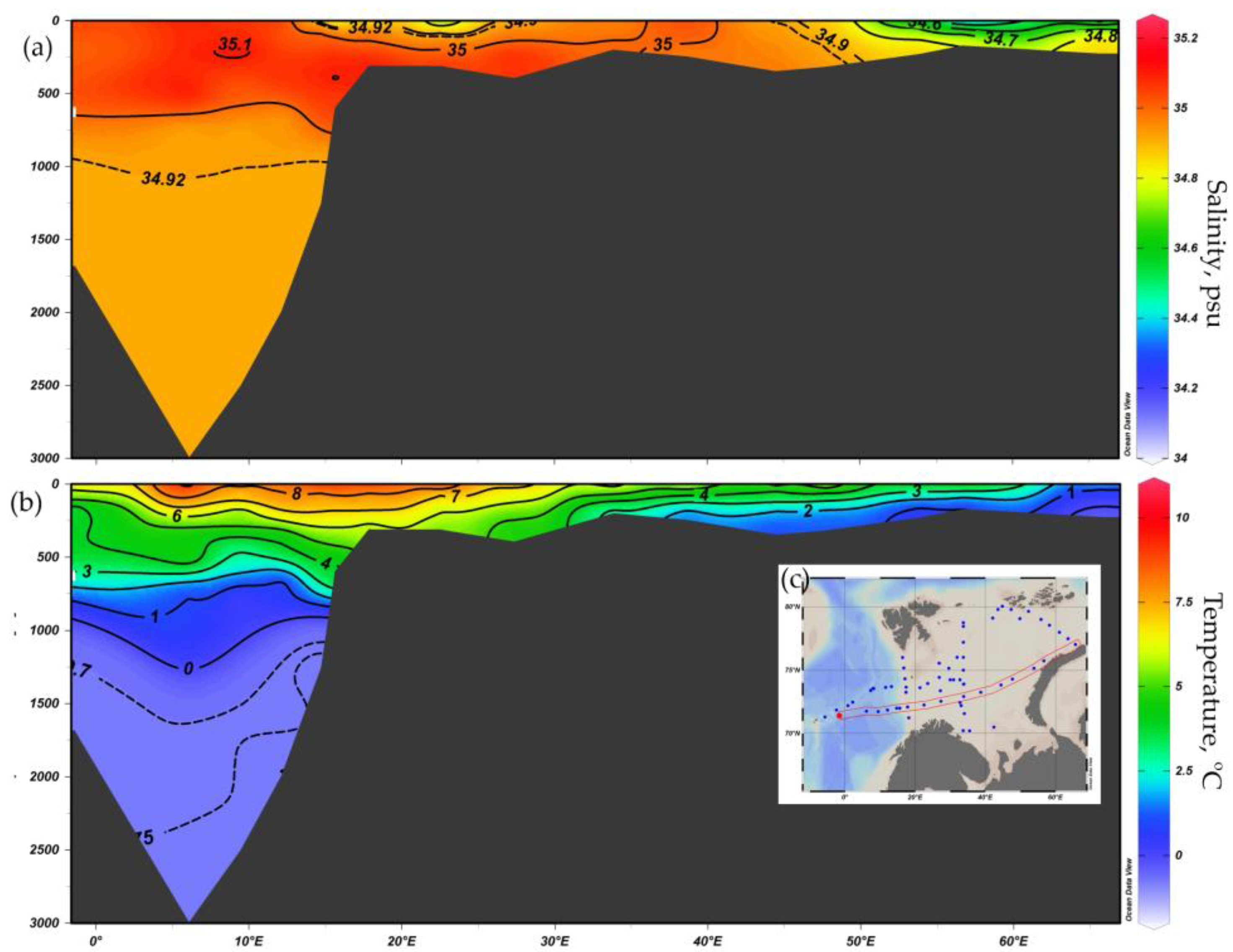
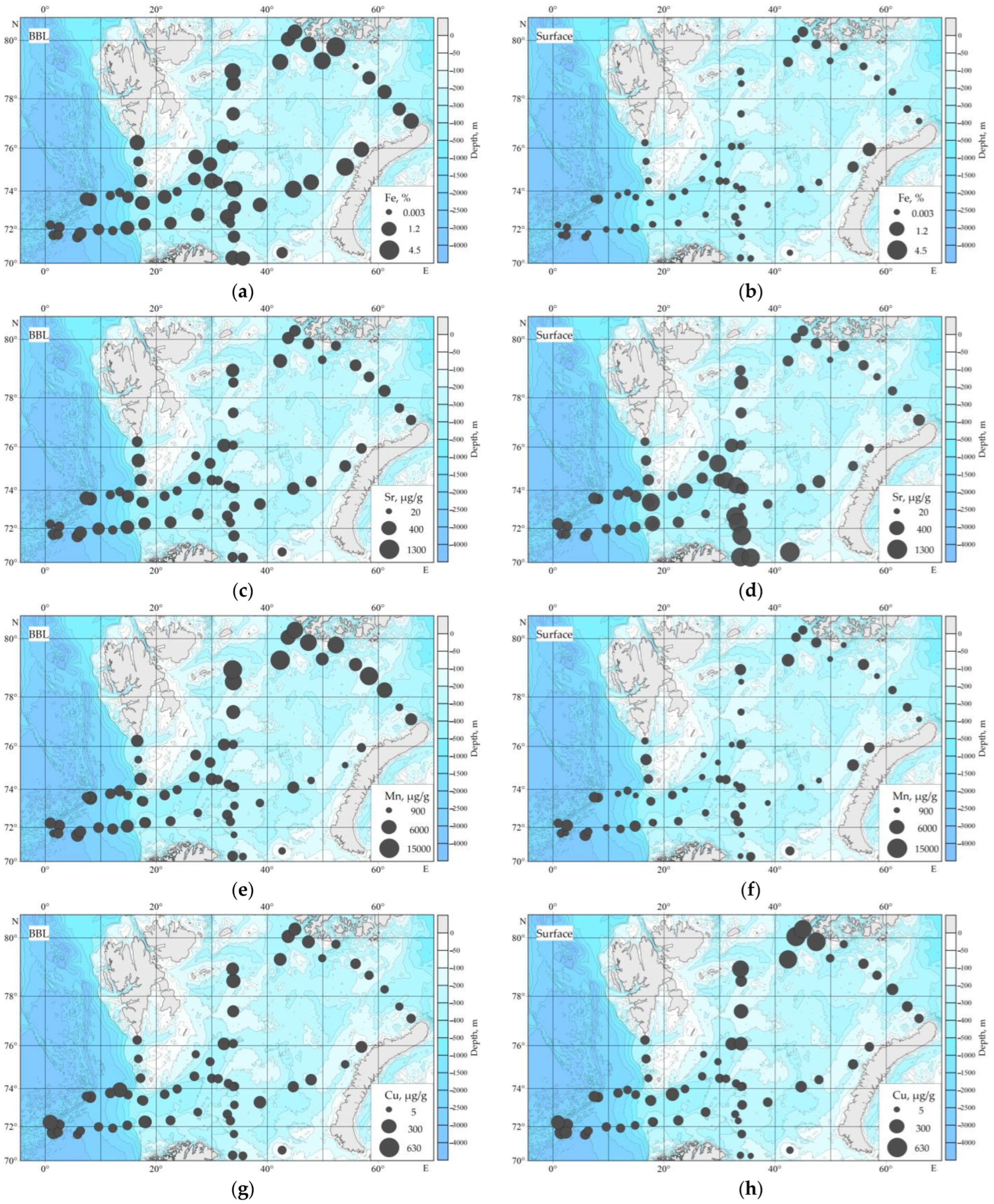
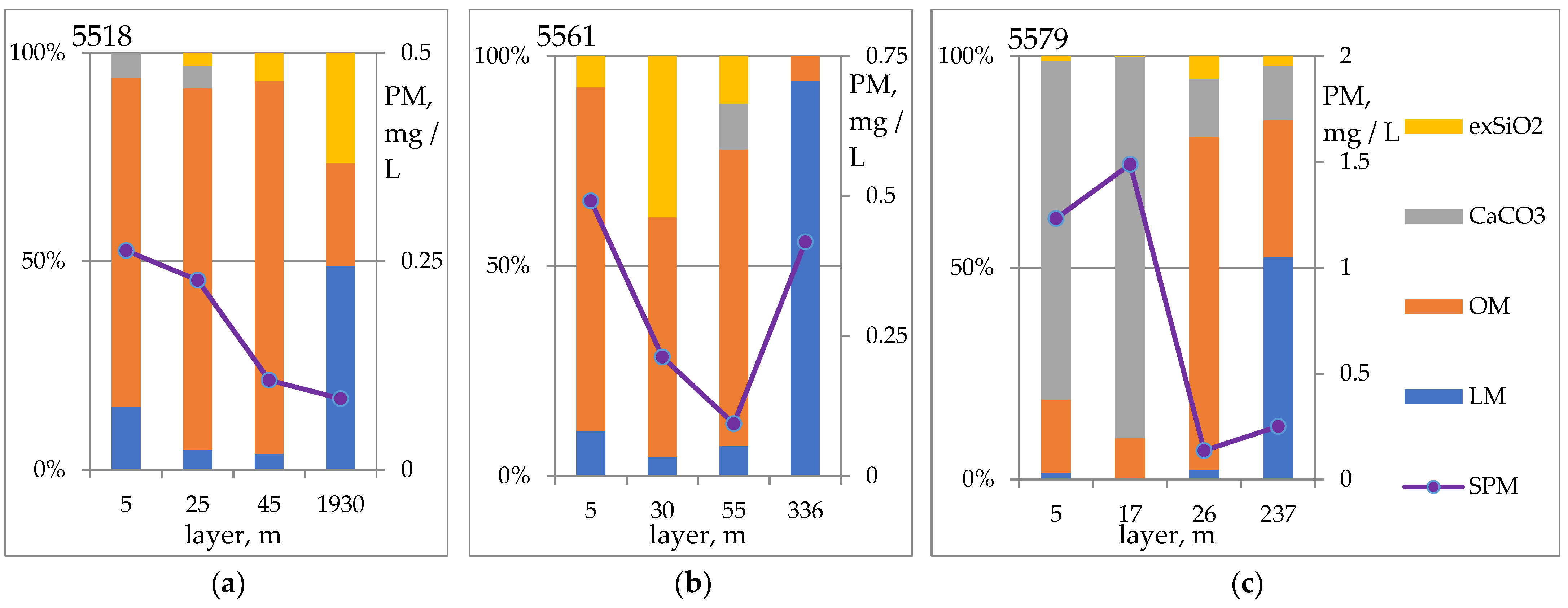
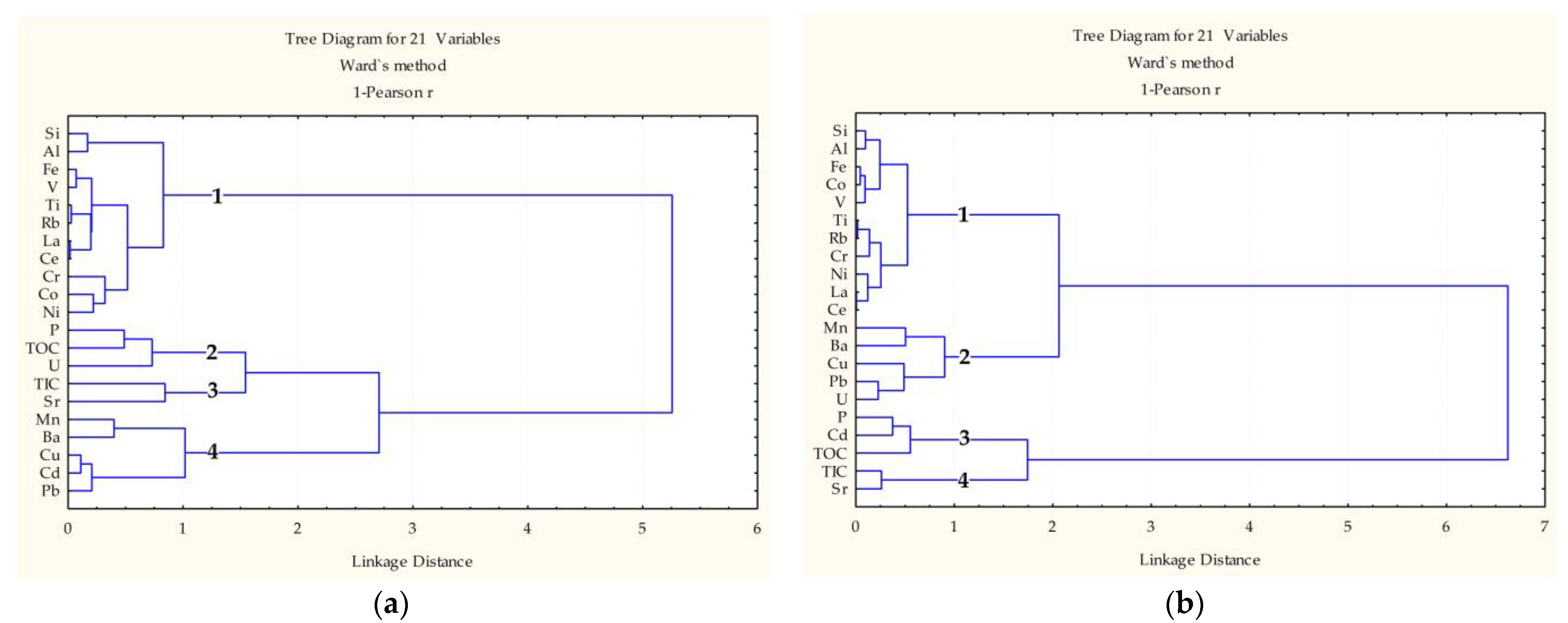
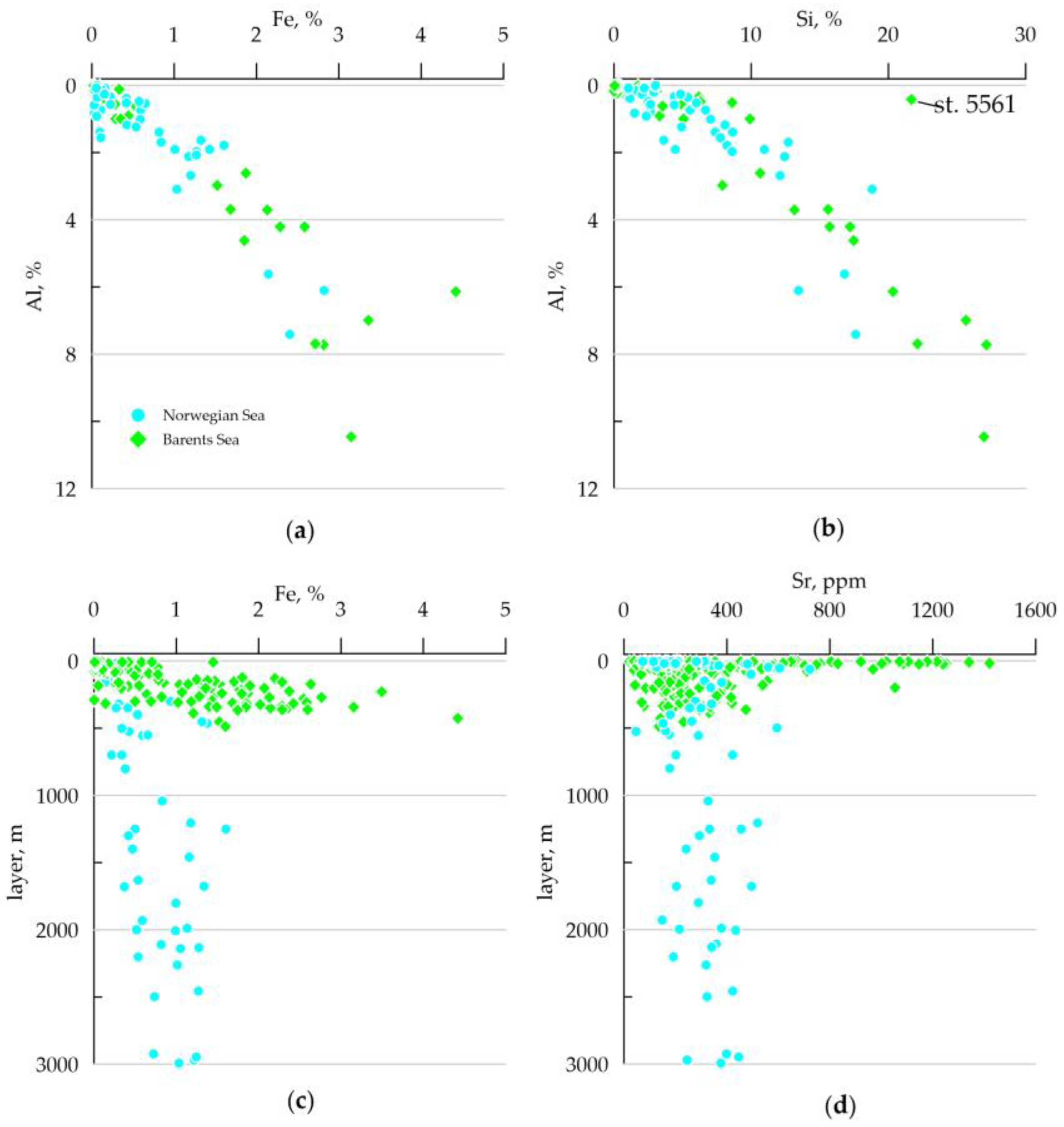

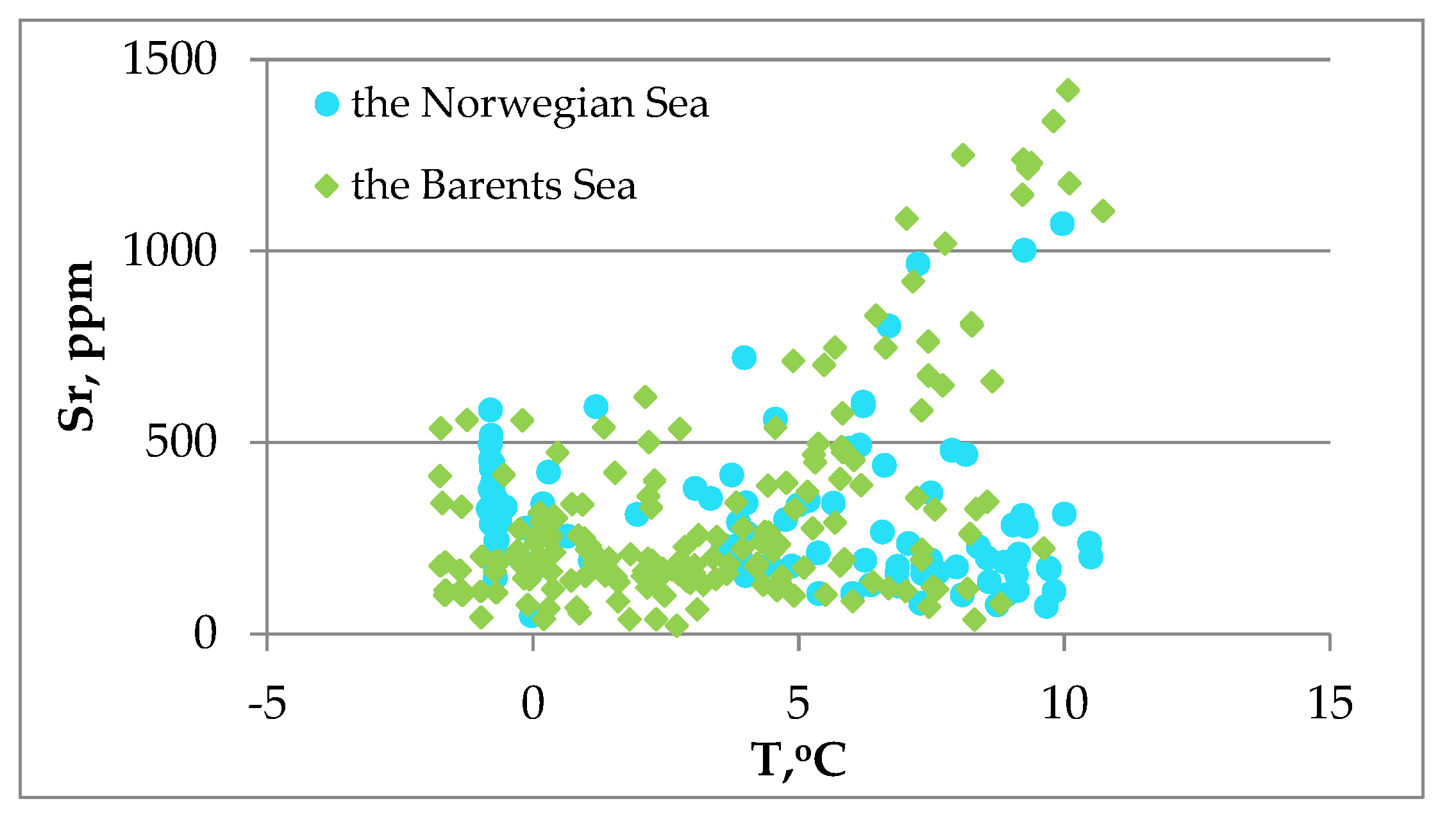

| Method | Measured Value | Number of Stations Studied | Number of Samples Analyzed |
|---|---|---|---|
| Coulometric titration | TC, TOC | 20 | 78 |
| Photocolorimetry | Si, Al, P | 20 | 78 |
| ICP-MS | Mn, Ti, V, Co, Ni, Cu, Rb, Sr, Cd, Ba, La, Ce, Pb, U | 65 | 295 |
| FAAS | Fe |
| Station | DD/MM/YY | Depth of Euphotic Layer, m |
|---|---|---|
| Norwegian Sea | ||
| 5516 | 19/07/2017 | 31 |
| 5521 | 21/07/2017 | 41 |
| 5523 | 22/07/2017 | 24 |
| 5525 | 23/07/2017 | 26 |
| 5528 | 24/07/2017 | 46 |
| 5531 | 25/07/2017 | 38 |
| 5533 | 26/07/2017 | 28 |
| 5535 | 27/07/2017 | 36 |
| 5540 | 29/07/2017 | 31 |
| Barents Sea | ||
| 5542 | 30/07/2017 | 44 |
| 5548 | 01/08/2017 | 20 |
| 5550 | 02/08/2017 | 18 |
| 5553 | 03/08/2017 | 38 |
| 5555 | 04/08/2017 | 51 |
| 5556 | 04/08/2017 | 25 |
| 5557 | 05/08/2017 | 48 |
| 5557A | 07/08/2017 | 43 |
| 5563 | 08/08/2017 | 32 |
| 5566 | 09/08/2017 | 51 |
| 5568 | 10/08/2017 | 24 |
| 5570 | 11/08/2017 | 36 |
| 5572 | 12/08/2017 | 29 |
| 5573 | 13/08/2017 | 34 |
| 5574 | 13/08/2017 | 23 |
| 5576 | 14/08/2017 | 18 |
| 5577 | 14/08/2017 | 15 |
| 5580 | 15/08/2017 | 12 |
| Fe (%) | Mn (%) | Ti (ppm) | V (ppm) | Co (ppm) | Ni (ppm) | Cu (ppm) | Rb (ppm) | Sr (ppm) | Cd (ppm) | Ba (ppm) | La (ppm) | Ce (ppm) | Pb (ppm) | U (ppm) | |
|---|---|---|---|---|---|---|---|---|---|---|---|---|---|---|---|
| the Norwegian Sea (15 stations) | |||||||||||||||
| 1 | 0.06 | 0.19 | 137.6 | 7.28 | 2.42 | 10.46 | 89.5 | 3.06 | 278 | 5.19 | 155 | 2.15 | 4.16 | 8.98 | 5.50 |
| (0.05) | (0.09) | (89.1) | (4.31) | (0.84) | (6.32) | (67.3) | (1.16) | (185) | (2.08) | (235) | (2.70) | (6.56) | (9.25) | (4.23) | |
| 2 | 0.47 | 0.29 | 1307 | 23.97 | 6.27 | 19.15 | 127.9 | 12.59 | 313 | 2.34 | 574 | 10.67 | 23.92 | 33.58 | 2.72 |
| (0.34) | (0.09) | (1168) | (13.14) | (2.63) | (12.21) | (54.1) | (11.86) | (119) | (1.89) | (238) | (8.47) | (16.49) | (18.37) | (2.48) | |
| 3 | 0.99 | 0.36 | 1472 | 39.18 | 9.67 | 24.86 | 158.8 | 21.54 | 340 | 3.88 | 558 | 12.37 | 28.83 | 65.11 | 1.80 |
| (0.39) | (0.12) | (1383) | (20.34) | (3.99) | (8.62) | (134.6) | (16.22) | (140) | (8.84) | (184) | (5.50) | (12.87) | (64.03) | (1.16) | |
| Bear Island Trough (6 stations) | |||||||||||||||
| 1 | 0.06 | 0.11 | – | 8.89 | 1.72 | 6.53 | 67.3 | 9.47 | 364 | 4.32 | 278 | 3.65 | 9.32 | 8.71 | 1.75 |
| (0.09) | (0.06) | (7.60) | (0.86) | (6.29) | (57.9) | (10.17) | (271) | (1.83) | (481) | (6.23) | (15.92) | (9.89) | (1.61) | ||
| 2 | 0.36 | 0.19 | 1014 | 24.08 | 4.12 | 10.16 | 76.6 | 11.31 | 216 | 2.07 | 235 | 7.60 | 16.06 | 22.27 | 1.39 |
| (0.15) | (0.04) | (186) | (7.14) | (1.49) | (6.71) | (37.3) | (7.65) | (53.8) | (1.30) | (163) | (2.49) | (5.86) | (6.95) | (0.50) | |
| 3 | 1.35 | 0.24 | 1964 | 87.01 | 8.49 | 21.68 | 42.3 | 48.46 | 222 | 1.35 | 322 | 18.01 | 41.89 | 27.86 | 1.59 |
| (0.30) | (0.05) | (624) | (31.77) | (1.87) | (6.43) | (15.6) | (14.82) | (83.9) | (0.48) | (130) | (2.96) | (7.54) | (5.33) | (1.06) | |
| the Barents Sea shelf proper (24 stations) | |||||||||||||||
| 1 | 0.09 | 0.18 | 472 | 27.2 | 2.37 | 13.88 | 140.3 | 8.90 | 250 | 3.30 | 349 | 3.96 | 8.17 | 14.02 | 2.37 |
| (0.14) | (0.15) | (376) | (34.4) | (1.78) | (20.6) | (132.5) | (9.96) | (219) | (1.91) | (584) | (10.52) | (19.61) | (11.89) | (2.61) | |
| 2 | 1.06 | 0.59 | 1349 | 123.7 | 10.95 | 37.02 | 252 | 56.12 | 355 | 5.60 | 848 | 22.88 | 43.89 | 46.73 | 2.03 |
| (0.82) | (0.46) | (1214) | (83.6) | (8.64) | (23.5) | (211) | (80.65) | (263) | (3.04) | (756) | (34.30) | (47.33) | (23.64) | (1.31) | |
| 3 | 1.61 | 0.48 | 1970 | 186.3 | 11.15 | 25.98 | 92.9 | 62.85 | 251 | 2.60 | 553 | 19.54 | 44.86 | 30.32 | 1.55 |
| (0.80) | (0.41) | (1126) | (118.5) | (6.14) | (15.3) | (64.9) | (42.96) | (105) | (1.31) | (344) | (7.18) | (16.48) | (11.14) | (0.74) | |
| Area of coccolithophorid bloom in the southern Barents Sea (5 stations) | |||||||||||||||
| 1 | 0.05 | 0.06 | 35 | 1.6 | 1.31 | 6.3 | 24.2 | 6.47 | 238 | 2.56 | 262 | 5.02 | 10.67 | 19.26 | 1.90 |
| (0.04) | (0.04) | (31) | (1.3) | (1.21) | (5.39) | (21.1) | (5.76) | (163) | (1.71) | (335) | (6.28) | (14.29) | (13.29) | (1.81) | |
| 2 | 0.41 | 0.20 | 328 | 18.0 | 4.9 | 16.0 | 46.1 | 18.12 | 186 | 3.22 | 404 | 9.06 | 21.89 | 32.40 | 1.84 |
| (0.31) | (0.06) | (125) | (9.6) | (1.3) | (9.5) | (35.4) | (12.05) | (116) | (1.21) | (371) | (3.78) | (9.36) | (20.34) | (1.43) | |
| 3 | 1.45 | 0.17 | 610 | 40.6 | 7.6 | 22.2 | 36.8 | 53.40 | 219 | 2.60 | 554 | 18.31 | 43.11 | 31.94 | 2.00 |
| (0.91) | (0.10) | (358) | (32.6) | (4.18) | (10.82) | (13.2) | (28.16) | (58) | (1.17) | (388) | (5.72) | (12.93) | (9.79) | (0.94) | |
Disclaimer/Publisher’s Note: The statements, opinions and data contained in all publications are solely those of the individual author(s) and contributor(s) and not of MDPI and/or the editor(s). MDPI and/or the editor(s) disclaim responsibility for any injury to people or property resulting from any ideas, methods, instructions or products referred to in the content. |
© 2023 by the authors. Licensee MDPI, Basel, Switzerland. This article is an open access article distributed under the terms and conditions of the Creative Commons Attribution (CC BY) license (https://creativecommons.org/licenses/by/4.0/).
Share and Cite
Starodymova, D.P.; Kravchishina, M.D.; Kochenkova, A.I.; Lokhov, A.S.; Makhnovich, N.M.; Vazyulya, S.V. Elemental Composition of Particulate Matter in the Euphotic and Benthic Boundary Layers of the Barents and Norwegian Seas. J. Mar. Sci. Eng. 2023, 11, 65. https://doi.org/10.3390/jmse11010065
Starodymova DP, Kravchishina MD, Kochenkova AI, Lokhov AS, Makhnovich NM, Vazyulya SV. Elemental Composition of Particulate Matter in the Euphotic and Benthic Boundary Layers of the Barents and Norwegian Seas. Journal of Marine Science and Engineering. 2023; 11(1):65. https://doi.org/10.3390/jmse11010065
Chicago/Turabian StyleStarodymova, Dina P., Marina D. Kravchishina, Anastasia I. Kochenkova, Alexey S. Lokhov, Natalia M. Makhnovich, and Svetlana V. Vazyulya. 2023. "Elemental Composition of Particulate Matter in the Euphotic and Benthic Boundary Layers of the Barents and Norwegian Seas" Journal of Marine Science and Engineering 11, no. 1: 65. https://doi.org/10.3390/jmse11010065
APA StyleStarodymova, D. P., Kravchishina, M. D., Kochenkova, A. I., Lokhov, A. S., Makhnovich, N. M., & Vazyulya, S. V. (2023). Elemental Composition of Particulate Matter in the Euphotic and Benthic Boundary Layers of the Barents and Norwegian Seas. Journal of Marine Science and Engineering, 11(1), 65. https://doi.org/10.3390/jmse11010065







